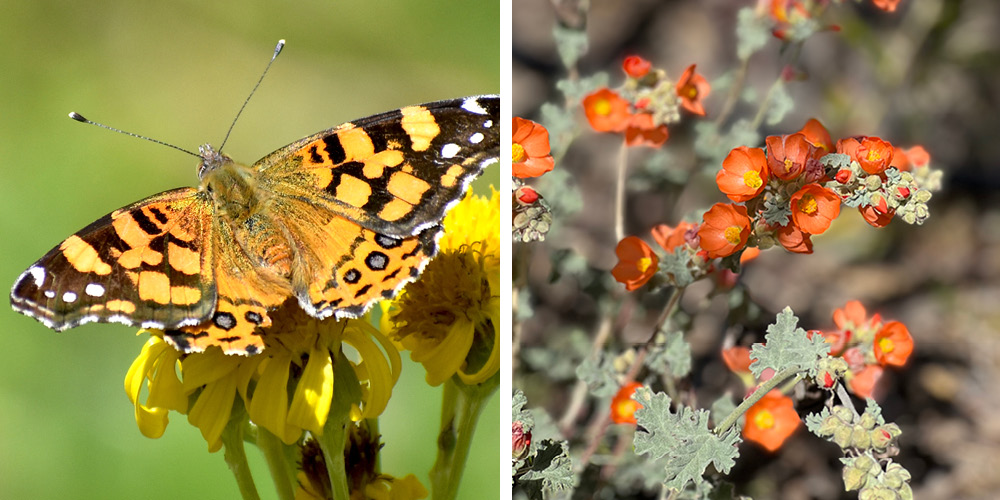Home grown insect enthusiasts have always provided valuable information to scientists about the ecology and health of invertebrate populations. It is often “amateur” lepidopterists who track rare subspecies, discover new populations, keep local natural history notes, or raise the alarm when butterfly populations are threatened. Today more than ever before, both organized community science programs and apps like iNaturalist are enabling everyone to contribute data on the status of insects.
Butterflies in particular continue to be a bellwether for declining insect populations, thanks in no small part to the collective data sharing efforts of thousands of individuals. For example, using community science data from iNaturalist and the North American Butterfly Association, recent research by Matt Forister and colleagues reveals that up to 80% (roughly 120) of the most widespread butterfly species in the western United States appear to be in some state of decline. Some species, like the formerly common west coast lady (Vanessa annabella) and large marble (Euchloe ausonides), appear to be in steep decline across much of their widespread ranges. Sadly, the monarch butterfly (Danaus plexippus) appears to be only one of many butterfly species we risk losing to habitat loss, pesticides, climate change, and other threats faced by insect populations today.
Identifying our most at-risk butterflies
Because these butterflies overlap in their ranges and can be found in many of the same habitats, there are opportunities to protect multiple species at the same time through our conservation practices. As a new staff member at the Xerces Society, I am proud to be expanding our efforts to protect the West’s most imperiled butterfly species. By working with scientists to come up with a ranking of the most at-risk western butterflies, we can now begin to assess their conservation needs and determine how to best protect them across the varied landscapes of the western US. This information is being used to develop a series of species profiles and other technical guidance for land managers. In addition, we are working with regional and state agencies to include these declining species on lists for conservation attention. These resources can help land owners, state and federal agency staff, and other stakeholders protect their local butterfly populations across the deserts, forests, and grasslands of the western United States.
Learn your local host plants (it’s more than just milkweed)
In addition to the work we are doing at the Xerces Society, anyone can play a role in protecting some of the West’s most at risk butterfly species. In addition to planting nectar sources that bloom through the entire growing season, planting and encouraging native plants that support caterpillars is the best thing that individuals can do to support local butterfly populations. Just like the monarch caterpillar needs milkweed (Asclepias spp.) to grow, each butterfly species requires particular “host plants” to feed on, and they aren’t always hard to find. The west coast lady, for example, feeds on plants we generally call mallows (Malva sp.), checkermallows (Sidalcea sp.), globemallows (Sphaeralcea sp.), and nettles including stinging nettle (Urtica dioica), among others. Plants in the mustard family (Brassicaceae) support the imperiled large marble and many other native butterflies in the Pieridae family. Like the butterflies they support, these plants can be found in wet and dry environments, urban and rural areas, near crop regions and in weedy lots. It’s also worth noting that many butterfly species will use introduced species of plants as caterpillar food plants in some areas, so protecting these non-native, often “weedy” plants from destruction is important when they are the only resources available, especially in urban habitats.

The west coast lady, Vanessa annabella, feeds on plants in the mallow (Malvaceae) and nettle (Urticaceae) families as caterpillars and is in steep decline across its range. Some preferred native caterpillar plants that make wonderful additions to yards and gardens (depending on your region) include Oregon checker-mallow (Sidalcea oregana) or desert globemallow (Sphaeralcea ambigua). (Photos L to R: Chris Halsch/University of Nevada, Reno; Kevil Burls/Xerces Society).
Protecting caterpillars and adult butterflies from pesticides, and protecting host plant populations from herbicide exposure, is also important. If you have a yard or garden, you can choose practices that minimize chemical use and target pest organisms without hurting native caterpillar populations. If you do use chemical pesticides, avoid spraying while insects are visiting flowers or near known caterpillar food plants. At a larger scale, you can support businesses that produce bee-safe plants (you can find a list here) and support farmers and products that protect pollinators through our Bee Better Certified program.
Observing nature around you is more important than ever
Finally, your observations of butterflies, bees, and other flying insects are more important than ever. Photographs from both urban and rural areas can help scientists learn more about the status of insect populations at a scale that is simply not possible without your help. Your observations from your yard, local parks, or wilder adventures continue to be used by Xerces staff and scientists across the globe. In addition to iNaturalist, organized community science programs like the Thanksgiving and New Years’ Western Monarch Counts and the North American Butterfly Association Count Program hold some of the longest running inventories of butterfly populations in the United States. There is also a growing network of regional programs where observers repeatedly survey the same location throughout the summer, a particularly powerful way to learn about how butterfly populations are responding to our changing world. During National Pollinator Week and throughout the year, I encourage you to go out, observe nature, contribute to a community science program, and help protect the biodiversity where you live today.
This work was funded by the Bently Foundation, New-Land Foundation, the U.S. Bureau of Land Management, and Xerces Society members.
Learn more:
- Resources for caterpillar food plants and butterfly nectar plants: Attracting Native Pollinators, Gardening for Butterflies
- Native Plant, Seed and Services Directory
- Bee-safe nursery plants
- Pollinator Conservation Resource Center
- Smarter pest management: Protecting pollinators at home
- Bee Better Certified
- Bumble Bee Atlas
- Firefly Atlas




